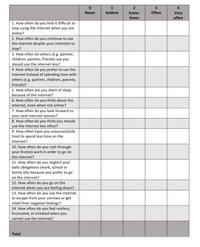Online addiction
WHAT ARE SUBSTANCE AND NON-SUBSTANCE RELATED ADDICTIONS?
Science defines various addiction criteria and distinguishes between substance and non-substance related addictions. Typical addiction criteria are craving, withdrawal symptoms, development of tolerance, loss of control, lack of interest and social withdrawal. Examples of substance related addictions are nicotine, alcohol, tranquillisers and painkillers, amphetamines, cannabis, ecstasy, LSD, opiates (heroin, morphine) and cocaine. In addition to these substance related addictions, there are non-substance related addictions that manifest themselves in the urge to engage in certain activities. Examples are the compulsive urge to gamble, shop, collect and hoard, work, play sports and have sex. Comparatively new addictions that are non-substance related are online gambling addiction and above all online addiction itself.
In contrast to non-substance related addictions, substance related addictions have been around for much longer and have thus been better researched. In science, substance-related addictions have been well described and clinically defined for a long time. Thus a wide range of treatment is available. Often, several addictive substances are found simultaneously (nicotine, alcohol, drugs, opiates etc.). When it comes to non-substance related addictions, on the other hand, diagnosis hitherto has been less well-grounded and treatment options less tried and tested. For this reason, terms like ‘online addiction’ are not yet as well established in people’s minds as are, for example, alcoholism or painkiller addiction.
Typically, there is a time lag of ten to fifteen years between the emergence and recognition of a new clinical picture. The cycle of the ICD (International Classification of Diseases, World Health Organization) is ten to fifteen years. The current ICD-11 came into force in 2022. For the DSM (Diagnostic and Statistical Manual, American Psychiatric Association), the cycle is ten to twenty years. The current DSM-5 dates from 2013.
Online gaming addiction is now recognised as a diagnosis and included in ICD-11 and DSM-5. Online addiction as such, on the other hand, is not yet officially recognised as a clinical picture. Problematic use of online computer games (‘internet gaming disorder’) is present when long duration and clear behavioural disturbances occur in combination. Since 2015, the DSM-5 has included a catalogue of criteria for online gaming addiction (five of nine criteria need to be met over a period of twelve months). In contrast to the ICD, online gaming addiction has so far only been classified in the DSM-5 as an object of research, and not as a clear clinical picture. It is expected to take ten to twenty years before online addiction is included in both the ICD and the DSM.
A well-known self-test for detecting online addiction is the CIUS questionnaire (Compulsive Internet Use Scale, see Fig. 1 below). With this, anyone can find out for themselves whether their own internet behaviour, via computer, tablet, smartphone and other terminal devices, should be regarded as problematic. The test consists of fourteen questions. There are five possible answers for each question, with points awarded between 0 (‘never’) and 4 points (‘very frequently’). The scores are added up at the end. A score of 20 to 27 points indicates problematic online behaviour. With a score of 28 out of 56 possible points, the subject is advised to seek help from an addiction counselling centre.
Fig. 1: Compulsive Internet Use Scale (CIUS), after Meerkerk et al. (2009)
WHY IS ONLINE ADDICTION A GLOBAL PHENOMENON?
Science and the internet industry have been dealing with the phenomenon of ‘online addiction’ in its various forms for years. Numerous studies, articles and circumstantial evidence exist. By strict scientific standards, there is as yet no formal recognition of online addiction, in view of the short time span of its occurrence. To identify problematic online behaviour, one generally looks at issues such as usage time, communication behaviour (e.g. on social networks), buying behaviour and sexual behaviour.
Broad sections of the population have been using the internet for about fifteen years. In the last five years, however, a strong growth in mobile internet use can be observed. One reason for this is the widespread use of smartphones in conjunction with high transmission speeds in mobile communications (3G, 4G).
A milestone for the mobile internet was the introduction of the iPhone in 2007. Global smartphone use has grown steadily since then, with the ratio of smartphone owners nearly exploding between 2016 (50%) and 2021 (82%). The number of Facebook users was around 50 million in 2007. By 2016, the number of users had risen to 1.8 billion and even to 2.7 billion by 2021 (in 2021, 60% of all internet users worldwide are registered with Facebook, 85% of whom only use Facebook on mobile). 4G/LTE has established itself as a global standard and revolutionised mobile internet use. The 5G roll-out has already begun. The powerful growth of the internet industry can be attributed, among other things, to the fact that it is subject to little or no regulation.
There have been numerous studies that deal with the problematic effects of excessive online use. In contrast, there are very few studies so far that describe positive effects (e.g. those associated with online learning media) and do not originate with the providers of these services.
When discussing the controversial topic of online addiction, it can help to ask the basic question: ‘What do I have to believe in?’ Let’s take ‘online addiction in children and young people’ as an example. For instance, what would I have to believe in if someone told me that online addiction is not a problem for this age group? In this case, I would have to believe the following statements to be true: ‘Three to four hours of social media, two to three hours of online games, more than 100 messages a day as well as the use of social networks to cope with emotions (boredom, worries, stress, escape from reality, anger) are a good thing for children and young people. Such online behaviour has positive and desirable effects on the formation of cognitive skills and social competence in an extremely important phase of life for brain and personality development.’ Who would subscribe to these statements without reservations? Probably only very few of our fellow human beings.
Almost all of humanity is currently on the online drug, albeit to varying degrees. This circumstance complicates the awareness of the problem and the development of measures to eliminate the global phenomenon of online addiction. In industrialised countries, 95 to 100% of people under the age of sixty now use mobile internet. For reasons of group dynamics, it is difficult to talk about drugs when almost everyone uses them in some way. In the last resort, there needs to be an awareness of the problem at the individual level. This requires an intellectual and emotional acceptance of the need for action.
The pressure to act is high, because waiting for scientific recognition of online addiction as an individual and ultimately global problem to come in about ten years would be a risky strategy. In his Nobel Peace Prize address in 1921, the Nobel laureate Christian Lange uttered the memorable sentence: ‘Technology is a useful servant, but a dangerous master.’ Let us now look at our user behaviour with the necessary inner distance. Let us look at the role of users and providers and then ask ourselves the following question: ‘Is the internet still a tool and a servant (Google Maps, WhatsApp, online travel bookings etc.), or is it on its way to becoming a master that tells us what to do, what to think and how to spend our time (Amazon, YouTube, Google, Facebook, Twitter, Instagram, TikTok etc.)?’ What answer do we arrive at?
Are we honest with ourselves and admit that we as individuals and as a society are very likely to have an increasing problem with the use of new technologies? Or do we resort to a tactic that social psychologists call ‘dissonance reduction’? On certain issues, we feel discomfort when our behaviour contradicts our beliefs (e.g. tobacco use, fast food, climate change). This uncomfortable feeling state is called ‘cognitive dissonance’. To resolve the dissonance, we then react with self-deception by playing down the problem, relativising the scientific findings, dismissing or denying them.

